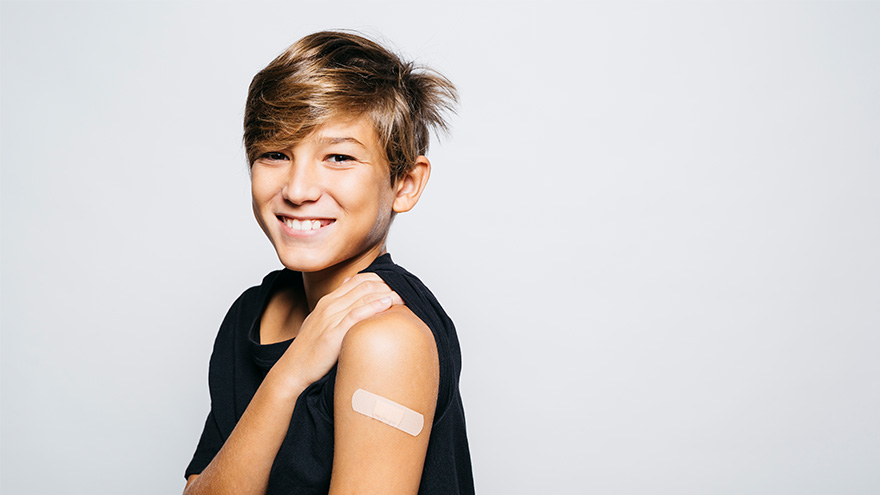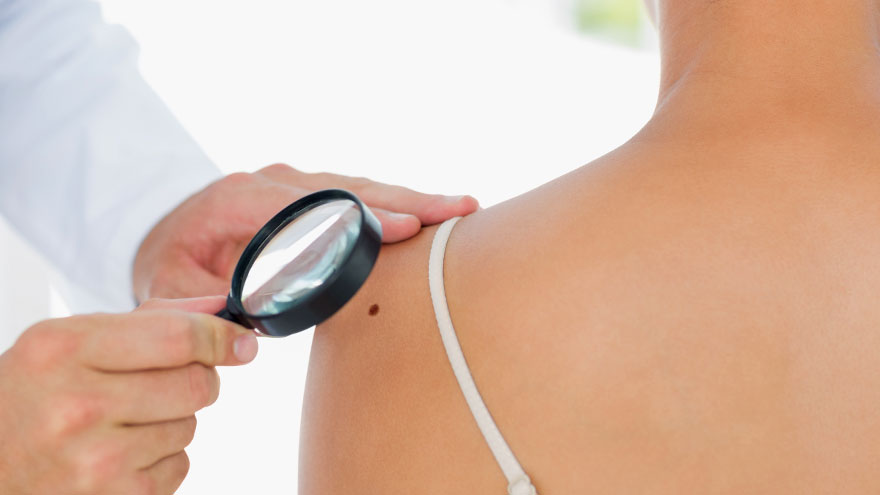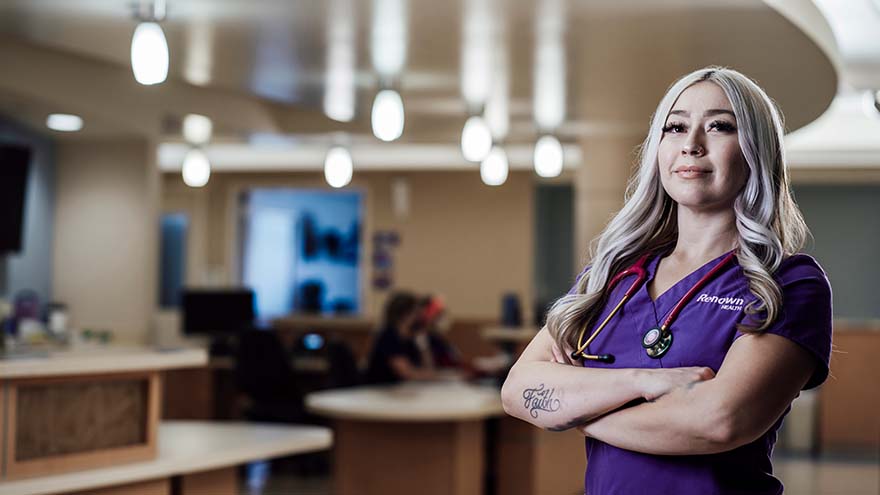Search
-
Handmade Bracelets a Labor of Love for Cancer Patients
The road through cancer treatment can test even the toughest of spirits. A local organization is handcrafting and donating beaded bracelets to the courageous women who have reached the finish line at Renown Infusion Services. After finishing her sixth and final cycle of chemotherapy at Renown Infusion Services, Joan Jackson told her nurse, Daun Russell, RN, she was tired. Russell returned with a box and opened it -- as she does for all cancer patients completing treatment -- and said, “pick one.” What Jackson was selecting was a beautiful, handmade bracelet crafted and donated by the local Soroptimist organization. Jackson picked a purple bracelet with a tag that read, "Congratulations on completing your treatment. Imagine what you can do now." “Picking the bracelet was such a special thing to mark my last day of chemo,” Jackson says. "Their gesture impacted me for the good after going through so much.” The women behind the bracelets Bev Perkins, a member of the Soroptimist International of Truckee Meadows, says the bracelet project began in 2009 as a way of celebrating those who completed cancer treatment. She wanted the project to be hands-on, so she involved the club members by organizing a small budget and asking others to donate jewelry. The group comes together each year to make the bracelets. Perkins disassembles the donated jewelry, adding newly purchased beads to make kits for the bracelets. The volunteers also add a metal tag inscribed with an inspiring word, like “believe,” “hope” or “love.” “It’s a labor of love for us,” says Kay Dumhan, group treasurer. “It’s to show empowerment and to help these women know there are people who are encouraged by them.” “When bracelets are donated there is usually quite a bit of feedback on how much it’s appreciated,” Dumhan says. “We never want to run out so we make sure we have a supply there. We’ve had cancer survivors as members and that makes it all the more personal.”
Read More About Handmade Bracelets a Labor of Love for Cancer Patients
-
Cervical Cancer Screenings Can Reduce Risk of Cancer
According to the American Cancer Society, approximately 14,100 new cases of invasive cervical cancer will be diagnosed, and 4,280 women will die from cervical cancer. However, cervical cancer is preventable with regular screening tests and the HPV vaccine. It’s important to note that medical advances have allowed progress in diagnosing and treating cervical cancer. While it used to be one of the most common causes of cancer death for American women, the incidence of death has significantly declined. What to Know About the HPV Vaccine HPV vaccination is the best way to prevent cervical cancer and is recommended for all youth starting as early as age 9, or for teens and adults up to age 45 who didn’t start or finish the series. In Nevada, only 50.1% of teens ages 13-17 have been vaccinated for HPV. There are 13 types of HPV, and the vaccine Gardasil 9 protects against 9 of those HPV strains, greatly reducing the incidence of cervical cancer among vaccinated individuals. What to Know About Cervical Cancer Screenings The CDC says the most important thing you can do to help prevent cervical cancer is to have regular screening tests starting at age 21. And there are two common tests that can detect early stages of cervical cancer (or precancer) and improve health outcomes. The pap test (or pap smear). This screening looks for precancers. Women should begin getting pap smears when they’re 21. The human papillomavirus (HPV) test looks for the virus that can cause these cell changes. Cervical Cancer Screening Schedule The American Cancer Society offers the following guidelines for screenings: All women should begin cervical cancer screening at 21. Women between 21 and 29 should have a pap test every three years. Beginning at 30, the preferred way to screen is with a pap test combined with an HPV test every five years. This is called co-testing and should continue until age 65. A pap test (or pap smear) is performed during a regular screening appointment to look for precancers, cell changes on the cervix that might become cervical cancer if they are not evaluated or appropriately treated. Typically outpatient procedures can reduce the risk of long-term health impacts that prevent pre-cancerous cells from becoming cancer cells. Women over 65 who have had regular screenings in the previous ten years should stop cervical cancer screening as long as they haven’t had any severe precancers found in the last 20 years. How to Get Screened Request an appointment with your primary care physician or OBGYN to schedule a screening.
Read More About Cervical Cancer Screenings Can Reduce Risk of Cancer
-
From Cancer Survivor to Caregiver
Meet Haley Carroll Being a new nurse comes with many challenges and gaining experience is a journey, but Haley Carroll’s first day on the job was far from her first day in a hospital. Haley was diagnosed with lymphoma right before her senior year of high school, and she was declared cancer-free on December 2, 2015. Inspired by the incredible care she received during her cancer treatments and during her time at Renown Children’s Hospital, Haley enrolled in nursing school at the University of Nevada, Reno. She graduated in December 2020, just five years after beating cancer. “I’ve always been interested in nursing,” Haley says. “But once I was diagnosed and began to see everything that my nurses did for me, I knew that that’s what I wanted to do for patients, too.”
-
HPV Vaccine: Prevention Is the Best Medicine
With more than 3 million cases in the United States each year, human papillomavirus (HPV) is a common sexually transmitted disease and can lead to the risk of several cancer diagnoses. Fortunately, a vaccine can prevent more than 90% of HPV cancers when given at the recommended ages. We talked to Renown Pediatrician Vanessa Slots, M.D., to learn more about HPV and the importance of getting your child fully vaccinated. What is HPV? Talking about sexually transmitted infections can be uncomfortable, but learning how HPV is spread is important for prevention. HPVs are spread via skin-to-skin contact. According to the National Cancer Institute, there are low/medium-risk HPVs that can cause warts and cervical dysplasia (abnormal cells on the cervix), and there are high-risk HPVs that can cause various cancers. HPV is perhaps most known for causing cervical cancer. Other cancers related to HPV are anal, vaginal, vulvar, penile and oropharyngeal cancers. In fact, men are four times more likely than women to suffer from HPV-associated oropharyngeal (mouth and throat) cancer. HPV is so common that nearly all sexually active people will be exposed at some point in their lifetime, with around half of infections being a high-risk virus. Benefits of the HPV vaccine Immunizations are safe and effective and have successfully reduced the transmission of many deadly diseases. The CDC (Centers for Disease Control and Prevention) states the HPV vaccine protects against infections that can lead to HPV related cancers and abnormal cells that can lead to cancer (precancers), as well as genital warts. The recommended HPV vaccine schedule The American Cancer Society states that the HPV vaccine is most effective when two doses are given to girls and boys between the ages of 9 to 12. There should be at least 6 months between the first and second dose. “You might be asking why your child needs to get the HPV vaccine at this young age when they are not sexually active,” says Dr. Slots. “Research shows that people have a better immune response to the vaccine when younger than in their late teens and early 20s.” For teens and young adults ages 13 through 26 who have not been vaccinated, getting the HPV vaccine is still highly effective in preventing cancers and genital warts. CDC recommended HPV vaccination suggestions: 2-dose schedule for people who get their first dose before their 15th birthday. 3-dose schedule for people who get their first dose on or after their 15th birthday. “By following the recommended HPV vaccine schedule and getting your child the correct number of doses, this will ensure they have adequate protection against HPV associated diseases including cancer,” says Dr. Slots.
Read More About HPV Vaccine: Prevention Is the Best Medicine
-
Learn to Spot Skin Cancer
With skin cancer affecting one in five Americans and 3.5 million new skin cancer cases diagnosed yearly, being proactive about prevention is vital to your health. Dr. Angela Walker, a dermatologist with Renown Dermatology, Laser and Skin Care, explains. The 5 stages of melanoma How should someone examine their skin for moles? I recommend practicing monthly head-to-toe self-examination of your skin, so you can find any new or changing moles or marks that might be cancerous or precancerous. Skin cancer is the most common of all cancers. It is also the easiest to cure if diagnosed and treated early. Therefore, self-examination can alert you to changes in your skin and aid in early skin cancer detection. Self-examination tips: Make sure you have a bright light, full-length mirror, hand mirror and a blow-dryer. Examine your face, especially your nose, lips, mouth and ears, both front and back. Thoroughly inspect your scalp, using a blow-dryer and mirror to expose each section. You might need to get a friend or family member to help. Check your hands carefully: palms and backs, between the fingers and under the fingernails. Continue up the wrists to examine your forearms' front and back. Standing in front of the full-length mirror, begin at the elbows and scan all sides of your upper arms. Don't forget the underarms. Next, focus on the neck, chest and torso. Women should lift their breasts to view the undersides. With your back to the full-length mirror, use the hand mirror to inspect the back of your neck, shoulders, upper back and any part of the back of your upper arms you didn't already check. Scan your lower back, buttocks and backs of both legs. Check the front and sides of both legs, thigh to shin, ankles, tops of feet, between toes and under toenails. Examine the soles of feet and heels.
-
Paola’s Story: Bringing Hope and Determination to Patient Care
You may recognize her from billboards around town or the cover of Renown's latest annual report, but what you might not know is the story behind the now-familiar face. Paola Espinoza-Patino is the oncology unit's associate nurse manager at Renown Regional, and she grounds her work in hope and determination daily. Meet Paola:
Read More About Paola’s Story: Bringing Hope and Determination to Patient Care
-
Lung Cancer Screening and Early Detection
Lung cancer is the leading cause of cancer deaths in both men and women in the U.S. The good news is the five-year survival rate increases dramatically if lung cancer is treated before spreading to other parts of the body. Julie Locken, MD, of Renown Health Imaging, explains more. What are the signs and symptoms of lung cancer? As you might expect, most lung cancer symptoms appear in the chest and can affect your breathing. Watch for signs such as: Persistent cough Constant chest pain Shortness of breath Wheezing Bloody or rust-colored phlegm Hoarseness Swelling of the neck Pain or weakness in the shoulder, arm or hand Recurring pneumonia, bronchitis or other lung infections Loss of appetite and loss of weight can also be signs of lung cancer That said, there are usually no symptoms in the early stages of lung cancer, which means getting screened can truly be a lifesaver. If you have a history of smoking, you should get screened as a precaution. What are the risk factors of lung cancer? Around 80% of lung cancer cases stem from a history of smoking tobacco. But there are other known causes, such as secondhand smoke, radon, asbestos and diesel exhaust. It’s important to do what you can to eliminate exposure to all of these to reduce your lung cancer risk. People with an immediate relative – a parent, sibling or child – diagnosed with lung cancer and people between 50 and 80 years old are also at higher risk and may need to consider screening. People who are at the highest risk are those with a history of smoking tobacco, particularly smokers who averaged one pack of cigarettes per day for 20 years or more, as well as former heavy smokers who quit in the last 15 years.






